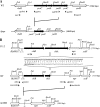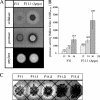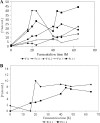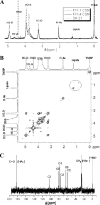Genetic improvement of Bacillus licheniformis strains for efficient deproteinization of shrimp shells and production of high-molecular-mass chitin and chitosan
- PMID: 20971870
- PMCID: PMC3008253
- DOI: 10.1128/AEM.01404-10
Genetic improvement of Bacillus licheniformis strains for efficient deproteinization of shrimp shells and production of high-molecular-mass chitin and chitosan
Abstract
By targeted deletion of the polyglutamate operon (pga) in Bacillus licheniformis F11, a derivative form, F11.1 (Δpga), was obtained that, along with lacking polyglutamate (PGA) formation, displayed enhanced proteolytic activities. The phenotypic properties were maintained in a strain in which the chiBA operon was additionally deleted: F11.4 (ΔchiBA Δpga). These genetically modified strains, carrying the Δpga deletion either alone (F11.1) or together with the ΔchiBA (F11.4) deletion, were used in fermentations (20-liter scale) aiming at the deproteinization of shrimp shells in order to obtain long-chain chitin. After chemical deacetylation, the resulting chitosan samples were analyzed by nuclear magnetic resonance spectroscopy, size exclusion chromatography, and viscometry and compared to a chitosan preparation that was produced in parallel by chemical methods by a commercial chitosan supplier (GSRmbH). Though faint lipid impurities were present in the fermented polysaccharides, the viscosity of the material produced with the double-deletion mutant F11.4 (Δpga ΔchiBA) was higher than that of the chemically produced and commercially available samples (Cognis GmbH). Thus, enhanced proteolytic activities and a lack of chitinase activity render the double mutant F11.4 a powerful tool for the production of long-chain chitosan.
Figures







Similar articles
-
Chemical Proprieties of Biopolymers (Chitin/Chitosan) and Their Synergic Effects with Endophytic Bacillus Species: Unlimited Applications in Agriculture.Molecules. 2021 Feb 20;26(4):1117. doi: 10.3390/molecules26041117. Molecules. 2021. PMID: 33672446 Free PMC article. Review.
-
Improved method for production of chitin and chitosan from shrimp shells.Carbohydr Res. 2020 Mar;489:107913. doi: 10.1016/j.carres.2020.107913. Epub 2020 Jan 17. Carbohydr Res. 2020. PMID: 32007692
-
Isolation and molecular characterization of chitinase-deficient Bacillus licheniformis strains capable of deproteinization of shrimp shell waste to obtain highly viscous chitin.Appl Environ Microbiol. 2006 Dec;72(12):7879-85. doi: 10.1128/AEM.00938-06. Epub 2006 Oct 6. Appl Environ Microbiol. 2006. PMID: 17028230 Free PMC article.
-
Preparation of chitosan from waste shrimp shells fermented with Paenibacillus jamilae BAT1.Int J Biol Macromol. 2021 Jul 31;183:1191-1199. doi: 10.1016/j.ijbiomac.2021.05.062. Epub 2021 May 11. Int J Biol Macromol. 2021. PMID: 33989684
-
Isolation and characterization of chitin and chitosan from marine origin.Adv Food Nutr Res. 2014;72:1-15. doi: 10.1016/B978-0-12-800269-8.00001-4. Adv Food Nutr Res. 2014. PMID: 25081074 Review.
Cited by
-
Transformation of the matrix structure of shrimp shells during bacterial deproteination and demineralization.Microb Cell Fact. 2013 Oct 5;12:90. doi: 10.1186/1475-2859-12-90. Microb Cell Fact. 2013. PMID: 24093594 Free PMC article.
-
Use of Nonspecific, Glutamic Acid-Free, Media and High Glycerol or High Amylase as Inducing Parameters for Screening Bacillus Isolates Having High Yield of Polyglutamic Acid.Int Sch Res Notices. 2014 Aug 7;2014:608739. doi: 10.1155/2014/608739. eCollection 2014. Int Sch Res Notices. 2014. PMID: 27379328 Free PMC article.
-
Stress responses of the industrial workhorse Bacillus licheniformis to osmotic challenges.PLoS One. 2013 Nov 15;8(11):e80956. doi: 10.1371/journal.pone.0080956. eCollection 2013. PLoS One. 2013. PMID: 24348917 Free PMC article.
-
Distinct roles of ComK1 and ComK2 in gene regulation in Bacillus cereus.PLoS One. 2011;6(7):e21859. doi: 10.1371/journal.pone.0021859. Epub 2011 Jul 1. PLoS One. 2011. PMID: 21747963 Free PMC article.
-
Chondroitin sulfate, hyaluronic acid and chitin/chitosan production using marine waste sources: characteristics, applications and eco-friendly processes: a review.Mar Drugs. 2013 Mar 11;11(3):747-74. doi: 10.3390/md11030747. Mar Drugs. 2013. PMID: 23478485 Free PMC article. Review.
References
-
- Bautista, J., M. Jover, J. F. Gutierrez, R. Corpas, O. Cremades, E. Fontiveros, F. Iglesias, and J. Vega. 2001. Preparation of crayfish chitin by in situ lactic acid production. Process Biochem. 37:229-234.
-
- Bhaskar, N., P. V. Suresh, P. Z. Sakhare, and N. M. Sachindra. 2007. Shrimp biowaste fermentation with Pediococcus acidolactici CFR2182: optimization of fermentation conditions by response surface methodology and effect of optimized conditions on deproteination/demineralization and carotenoid recovery. Enzyme Microbiol. Technol. 40:1427-1434.
-
- Brugnerotto, J., J. Desbrières, L. Heux, K. Mazeau, and M. Rinaudo. 2001. Overview on structural characterization of chitosan molecules in relation with their behavior in solution. Macromol. Symp. 168:1-20.
-
- Chang, S., and S. N. Cohen. 1979. High frequency transformation of Bacillus subtilis protoplasts by plasmid DNA. Mol. Gen. Genet. 168:111-115. - PubMed
-
- Chen, H. C., K. A. Phang, S. D. Wu, and W. J. Mau. 2001. Isolation of chitin from shrimp shells deproteinized by Candida parapsilosis CCRC 20515. Food Sci. Agric. Chem. 3:114-120.
Publication types
MeSH terms
Substances
LinkOut - more resources
Full Text Sources
Molecular Biology Databases
Miscellaneous

